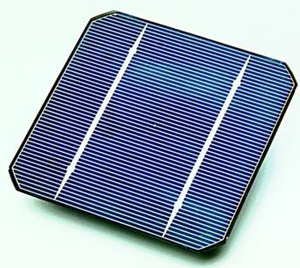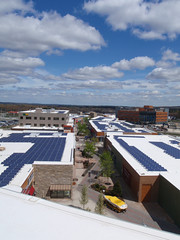Photovoltaic cells—those black squares an array of which comprises a solar panel—are getting more efficient, and gradually less expensive, all the time, thanks to ever-better designs which all them to focus the gathered sunlight on a more and more concentrated point. The size of the cells is decreasing as their efficiency rises, meaning that each cell becomes cheaper to produce and at once more productive. As far as the aforementioned cost, the price of producing solar-generated energy per watt hour has come down to $4.00 (or less) at the time of this writing. Just 17 years ago, it was nearly double that cost.
|
|
| Photovoltaic cells produce electricity directly from sunlight (Photo credit: Wikipedia) |
Solar powered electricity generation is certainly good for the environment, as this alternative form of producing energy gives off absolutely zero emissions into the atmosphere and is merely utilizing one of the most naturally occurring of all things as its driver. Solar collection cells are becoming slowly but surely ever more practical for placing upon the rooftops of people's homes, and they are not a difficult system to use for heating one's home, creating hot water, or producing electricity. In the case of using the photovoltaic cells for hot water generation, the system works by having the water encased in the cells, where it is heated and then sent through your pipes.
Photovoltaic cells are becoming increasingly better at collecting sufficient radiation from the sun even on overcast or stormy days. One company in particular,
Uni-Solar
, has developed solar collection arrays for the home that work well on inclement days, by way of a technologically advanced system that stores more energy at one time during sunlit days than previous or other arrays.
There is also another solar power system available for use called the
PV System
. The PV System is connected to the nearest electrical grid; whenever there is an excess of solar energy being collected at a particular home, it is transferred to the grid for shared use and as a means of lowering the grid's dependence on the hydroelectrically-driven electricity production. Being connected to the PV System can keep your costs down as compared to full-fledged solar energy, while at once reducing pollution and taking pressure off the grid system. Some areas are designing centralized solar collection arrays for small towns or suburban communities.
Some big-name corporations have made it clear that they are also getting into the act of using solar power (a further indication that solar generated energy is becoming an economically viable alternative energy source). Google is putting in a 1.6 megawatt solar power generation plant on the roof of its corporate headquarters, while Wal-Mart wants to put in an enormous 100 megawatt system of its own.
Nations such as Japan, Germany, the United States, and Switzerland have been furthering the cause of solar energy production by providing government subsidies or by giving tax breaks to companies and individuals who agree to utilize solar power for generating their heat or electrical power. As technology advances and a greater storage of solar collection materials is made available, more and more private investors will see the value of investing in this “green” technology and further its implementation much more in the years to come.
A Few Innovative New Solar Power Products:



hey. the article was quite inspiring and informative. thanks for shedding light on the matter.
ReplyDeleteResidential Solar Panels